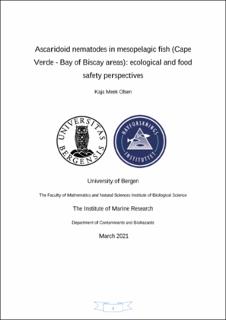| dc.description.abstract | The total amount of mesopelagic fish biomass is estimated to be between 1 and 20 billion tons globally. However, there is currently no industrial fishery for them. As the sustainability of harvesting pelagic fishes and the health constraint of replacing marine lipids/proteins with land-based lips/proteins in the feed for farming fish seem to have reach their limits, there is an increasing interest of exploitation of mesopelagic fishes from fishing companies and fish feed producers. Although, some anisakid ascaridoid nematodes (some Anisakis and Pseudoterranova spp.) infect many marine teleosts worldwide and are causative agents of a fish-borne zoonotic disease to humans known as anisakidosis. This gastrointestinal disease may result from ingestion of live larvae with lightly cooked or raw fishery products. The Anisakis species A. simplex (s.s.) and A. pegreffii may also cause allergic reactions in sensitized patients. Considering mesopelagic fish as new fish recourse, it is then important to know their ecological role as well as the possible health risks that may be associated with ascaridoid parasites. In May 2019, a research cruise was carried out from Cape Verde to the Bay of Biscay, trawling mesopelagic fish. A total of 1271 fish specimens of 32 fish species were sampled for the presence of ascaridoids. From these, 13 species were found infected with a total of 177 ascaridoid individuals, all larvae. Molecular identification (Cox2, ITS) suggests the larvae to belong to 8 different species: Anisakis pegreffii, A. typica, A. ziphidarum, A. brevispiculata, A. paggiae, A. cf. paggiae, Pseudoterranova cf. ceticola and Raphidascarididae sp. Diretmus argenteus and Diaphus rafinesquii were the most infected fish species with an ascaridoid prevalence of 78% and 36%, respectively. The total density was estimated at 71 ascaridoids/Kg fish. It appears that there is a high diversity of ascaridoid nematodes in mesopelagic fish and that these are likely important transport hosts in the life cycle of these parasites. Results suggest the existence of spatial variation in the abundance and diversity of ascaridoids in mesopelagic fish i.e. D. argenteus. In the perspective of food safety, the potential presence of i.e. A. simplex thermostable cross-allergens in mesopelagic fishes should be considered if derived products are meant to be destined as feed for farmed fish. | |
